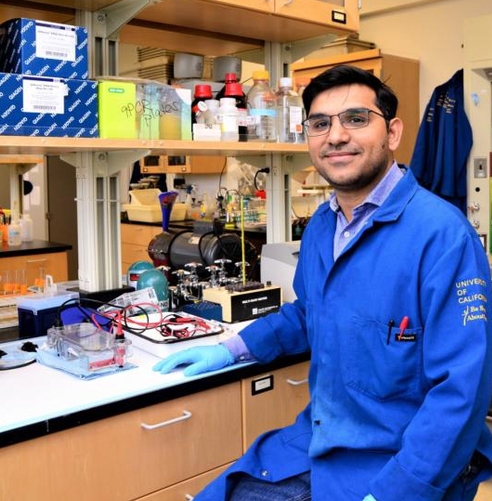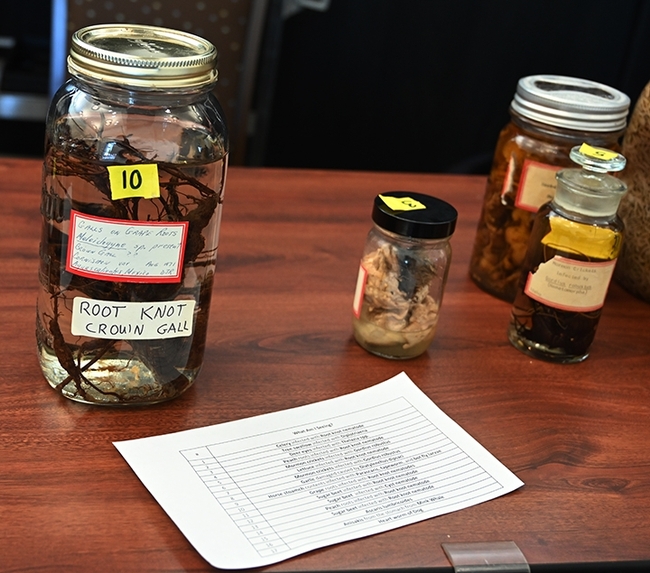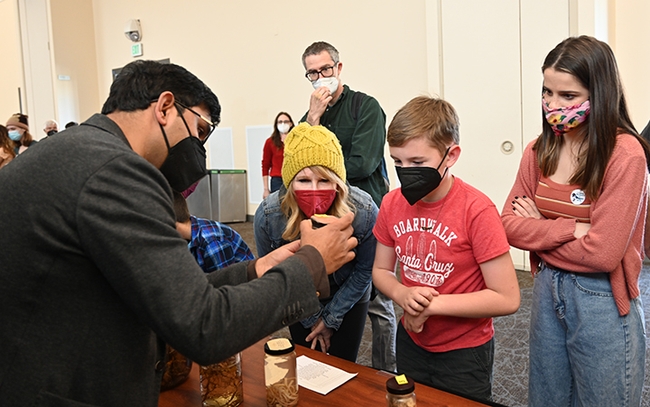
What's a nematode? Short answer: round worm.
Nematologist Shahid Siddique, assistant professor, UC Davis Department of Entomology and Nematology, is gearing up for the display in the lobby of the Katherine Esau Science Hall, formerly known as the Sciences Laboratory Building. It's located across from the front entrance of Briggs Hall.
"Research in the Siddique lab focuses on basic as well as applied aspects of interaction between parasitic nematodes and their host plants," he says on his website. "The long-term object of our research is not only to enhance our understanding of molecular aspects of plant–nematode interaction but also to use this knowledge to provide new resources for reducing the impact of nematodes on crop plants in California."
Here's a list of what visitors will see in the nematode display:
- Celery infected with root-knot nematodes
- Anisakis nematodes from a Minke whale stomach
- Heart of a dog infected with heartworms (Dirofilaria immitis)
- Parasitic nematodes (Baylisascaris transfuga) isolated from the stomach of a bear
- White-tailed deer eye infected with parasitic nematodes (Thelazia spp.)
- Sugar beet infected with root-knot nematodes
- Dog ascaris (Toxocara canis) cause of visceral larva migrans
- Common parasitic worms of human (Ascaris lumbricoides) cause of Ascaris isolated from human intestine
- Dog intestine infected with whipworms
 A root knot crown gall display. (Photo by Kathy Keatley Garvey)
A root knot crown gall display. (Photo by Kathy Keatley Garvey) - Horse stomach parasite community including 1) Parascaris 2) Tapeworms 3) Botfly larvae
- Yam infected with root-knot nematode
- Tomato root infected with root-knot nematode
- Adult raccoon roundworms
- Filarial nematodes (Onchocerca volvulus) cause of Onchocerciasis river blindness
- Zoonotic hookworms (Ancylostoma caninum)
- Ascaris lumbricoides (common parasitic worms of human)
- Tree swallow infected with Diplotriaena nematode
- Sugar beet infected with cyst nematode (Heterodera schachtii)
- Grape roots infected with Root-knot nematodes
- Mormon crickets infected with horsehair worms (Gordius robustus)
- Peach roots infected with root-knot nematodes
- Anisakis nematodes from fish intestine
- Hysterotahylaciun nematodes isolated from fish
- Pinworms isolated from human intestine
- Whipworms isolated from human Intestine
- Anisakis nematodes isolated from seals
- Adult dog heartworms
The 11 museums or collections featured on Feb. 18 are:
- Anthropology Museum, 328 Young Hall and grounds, noon to 4 p.m.
- Arboretum and Public Garden, Habitat Gardens in the Environmental GATEway, adjacent to the Arboretum Teaching Nursery on Garrod Drive, 9 a.m. to 1 p.m.
- Bohart Museum of Entomology, Room 1124 and main hall of the Academic Surge Building, Crocker Lane, 9 a.m. to noon and 1 to 4 p.m.
- Botanical Conservatory, the greenhouses along Kleiber Hall Drive, 11 a.m. to 3 p.m.
- California Raptor Center, 1340 Equine Lane, off Old Davis Road, 9 a.m. to 3 p.m.
- Center for Plant Diversity, Sciences Laboratory Building/Esau Science Hall, off Kleiber Hall Drive, 11 a.m. to 3 p.m.
- Nematode Collection, Sciences Laboratory Building/Esau Science Hall, off Kleiber Hall Drive, 9 am. to 3 p.m..
- Marine Invertebrate Collection, Sciences Laboratory Building/Esau Science Hall, off Kleiber Hall Drive, 9 am. to 3 p.m.
- Museum of Wildlife and Fish Biology, Room 1394, Academic Surge Building, 455 Crocker Lane, 10 a.m. to 2 p.m.
- Paleontology Collection, Department of Earth and Planetary Sciences, 1309 Earth and Physical Sciences Building, 434 LaRue Road, 12 noon to 4 p.m.
- Phaff Yeast Culture Collection, Robert Mondavi Institute Brewery and Food Processing facility, Old Davis Road, 10 a.m. to 2 p.m. (See news story)
Maps are available online and also will be handed out at the Biodiversity Museum Day, said Tabatha Yang of the Bohart Museum, chair and a co-founder of Biodiversity Museum Day. Visitors can purchase food from assorted food trucks. Those who wish to donate to the event can access this UC Davis crowdfunding page.
Attached Images:

